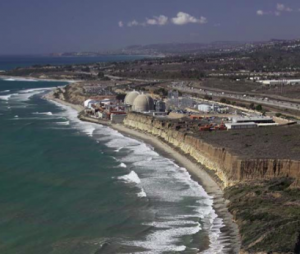
As a result of findings from a radiation leak inspection at the San Onofre Nuclear Generating Station, regulatory officials now plan a series of local meetings this summer exploring unresolved issues that will keep the plant offline indefinitely.
A first meeting this past Monday in San Juan Capistrano concerned the NRC’s inspection of worn metal tubes that leaked radioactive gas from one of two nuclear power generators, forcing a shutdown on Jan. 31 at the surfside power plant south of San Clemente. Power was subsequently turned off in the second generator, which later showed more tubes with wear caused by friction.
For the first time in the nuclear power industry, said NRC officials, tube-to-tube wear was found, which constituted an overriding danger and resulted in the plant’s offline status since.
Unit 2, the first to be closed, showed two tubes with wear while Unit 3 evidenced 326 tubes with wear, officials said. “The reason we’re here tonight is because of the unexpected tube-to-tube wear,” said Elmo Collins, NRC’s chief regional administrator.
Nine percent of the tubes in Unit 3 and 12 percent in Unit 2 showed wear through the tube walls of 10 percent or more, according to Pete Dietrich, senior vice-president and chief nuclear officer at Southern California Edison, the plant’s operator.
Tube retaining walls, intended to reduce vibration, became another concern of the generators’ failure. The supporting structures were found to be vibrating against the tubes and causing wear, which became apparent during Unit 3’s inspection, according to the NRC’s findings. “The risks did increase by quite a bit,” said Greg Warner, head of the NRC’s inspection team. “At this stage, they (Edison) haven’t done enough to demonstrate safety.”
Collins said the NRC will hold the licensee, SCE, accountable, if necessary, which could include future fines and penalties.
Changes to the two steam generators at San Onofre are under scrutiny as to whether they constitute design changes rather than parts replacements. The changes may have caused excessive gas tube wear resulting in a radioactive gas leak. If considered a new design, the changes would require a relicensing process.
A point of contention for future agendas, conceded Collins, is the agency’s need to revamp its licensing requirements with plant operators to lessen the potential of radioactive gas leaks.
“We wouldn’t be here today if Edison had told the NRC these were significant design changes and we should go through a license amendment process that the public can be part of,” commented audience member Dan Hirsch, president of the Committee to Bridge the Gap, a nonprofit nuclear policy organization focusing on issues of nuclear safety, waste disposal and disarmament.
Warner said the NRC was aware of the changes that Edison made to the generators. Edison’s current license does not reflect design changes, said Friends of Earth climate and energy campaign director Damon Moglen. “We see this as a sham process.”
In an attempt to prevent restarting the sidelined reactors, Moglen said his organization has filed legal documents demanding a transparent process and the required public hearings.
Residents within the power plant’s service area asked pointed questions, particularly about the root cause of the gas leak. NRC officials explained that the velocity of the radioactive water coming from the nuclear generator was too high for the nickel-and-iron gas tubes to handle, attributing that miscalculation to a faulty computer simulation of the steam-generating system.
Reasons for extreme velocity will be discussed at future meetings, said NRC officials.
Other questions concerned the level of radioactive gas leakage, the necessity of independent analysis, the possibility of using alternative wind and solar energy sources as well as reducing energy demand through conservation.
Collins said it will be months before the power plant will operate again. For the summer, two retired natural gas generators in Huntington Beach will temporarily supply electrical power and are expected, along with conservation efforts, to prevent any power outages, according to utility officials.





[…] Laguna Beach Independent – Long Hot Summer of Debate Over San Onofre […]